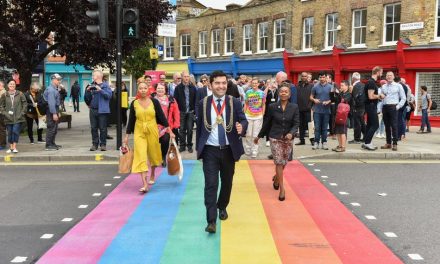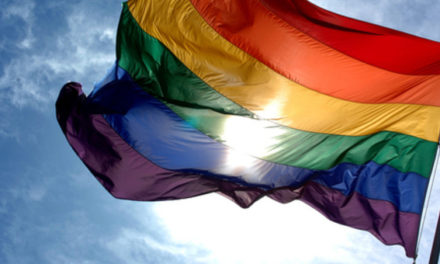Who do you follow on Instagram? If you’re anything like me it’s a mixture of celebrities, bands I like, friends, attractive people I’ll probably never meet, and let’s not forget the cute little animal accounts. However, one profile that’s definitely worth adding to your list and that is @LGBT_History.
The profile only launched at the beginning of the year and has since gained over 35,000 followers. The account posts a wide range of images from Pride marches, significant protests, and historical photos of LGBTI people, with a few words as an explanation.
The Instagram account came about as an idea by Washington, D.C. private attorneys Leighton Brown and Matthew Reimer (pictured above). SameSame.com.au caught up with the pair of unexpected online LGBT History curators to find out a bit more about their increasingly popular Instagram account.
The two explained the idea to create @LGBT_History came about when the two attended the unveiling of the headstone of American LGBT pioneer Frank Kameny in November 2015. Both Leighton and Matthew were already avid readers and collectors of LGBT historical paraphernalia, and from here their obsession grew.
In January of 2016, Leighton started to upload the pictures that he had been collecting. Matthew admits the two didn’t have much of a plan other than knowing the images were helping the two to discover a great deal about their community’s history, as well as the extent to which LGBT history had been erased from greater society. The two believed Instagram would be a great tool to share the stories of the incredible people, places, and events that mainstream history seems to have ignored or forgotten.
While the two found they felt a strong connection to the pictures and stories they were sharing, they also discovered they weren’t the only ones. Realising there was a need for resources that introduce LGBT history in an accessible format, Leighton and Matthew turned to social media platform, Instagram.
The two admit they’re “not experts” but have gotten consistently better at researching and tracking down source material. “We spend an inordinate amount of time on the account.” they tell SameSame.com.au, “And we keep the account going because it’s meaningful to us and we hope it’s meaningful to others.”
Both Leighton and Matthew’s experience with @LGBT_History has allowed them to personally feel more at home in the queer community, saying “It has given us a greater understanding of our community’s story both independently and in terms of history as a whole.”
While the Internet is full of social media outlets that post imagery from LGBT history, they found many had little to no correct information; and that there is a need for more accuracy in presenting LGBT history.
“It is vastly important that queer history be told and that it be told accurately and within the appropriate context. It is one thing to post the pictures, it is another thing to post the pictures with as much objective information as possible. We think that our focus on the information sets us apart.”
“All of these pictures have an origin, and the vast majority of those primary sources have the correct date, location, photographer, and other information; we track those sources down and put up the information. And, what’s incredible, is that when we find the primary source, we usually end up learning about some random Gay Activists, Alliance zap or a Queer Nation visibility action or some other event about which we didn’t know.”
The pair explains,“Ideally, we hope, we provide enough information so that people will be able to follow up on areas of interest; at that point, they can take what little we have been able to say in 2,200 characters and go to the experts, the archives, the academics (or just Wikipedia), and learn more.”
This obsession with providing accurate information alongside the account’s imagery helped @LGBT_History gained popularity, and the two now find themselves receiving a lot of messages from their followers. Some share personal stories, while others simply thank the pair for what they’ve been doing:
“Thank you for all the great gay history that reminds me what people did in the past so I can be who I am today,” wrote one follower in a message.
“That’s pretty much the idea,” they tell SameSame.com.au. “Our goal really is to draw attention to all the incredible people who made our ongoing fight possible.”
Leighton and Matthew acknowledge that the account has given them an appreciation for the value of the images that survive from queer history.
“The pictures that we feature were taken by those who were confident enough to do the photographing and are of those who were proud enough to be photographed, subversive acts in and of themselves.”
“As we rarely post any pictures from after 2000, we’re talking about a universe of images that were not created in the digital age, and that we have therefore only discovered because they have been digitised.”
The two encourage people to get involved by following the @LGBT_History Instagram account, sharing it with friends; but even more importantly, they would be honoured to receive any submissions of pre-2000 LGBTI life. They go on to add that submissions don’t have to be limited to Pride or protest events; with candid photos of couples, friends, families, bars, etc being more than welcome. They also want to spread the word about how vital it is that LGBTI people digitise their pictures for future generations.
“Our history is just sitting out there in albums, shoeboxes, attics, garages, and other nooks and crannies; we need to make sure we capture it,” the pair of unexpected online LGBT history curators say.
“And that speaks to a larger point: LGBT elders are incredible sources of information, strength, guidance, friendship, and power. While we are excited by the reaction that we’ve seen to historic imagery, we also hope that it encourages younger LGBTs to seek out the wisdom of those who lived through the events.”
You can check out @lgbt_history on their Instagram account and email them your pictures via lgbt.history.ig@gmail.com.
Article originally published as a feature on SameSame.com.au









Facebook Comments